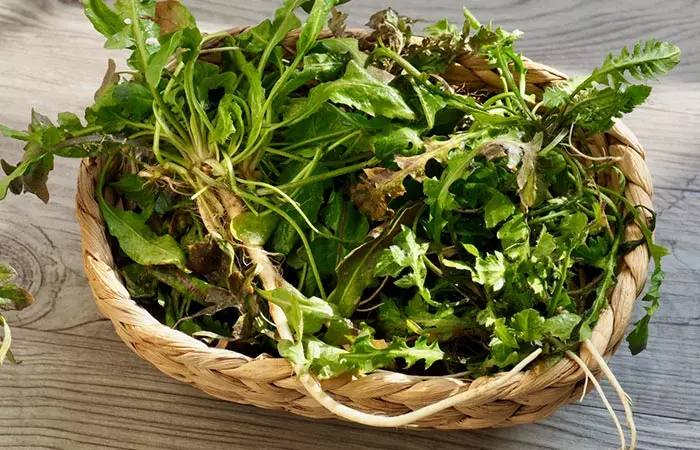Home Remedies For Adenomyosis
1. Heating Pads
A heat compress may enhance the blood flow to the pelvic area and help with relaxation and relieve the building pressure and pain in the uterus (1). You Will Need A heating pad or a hot compress What You Have To Do How Often You Should Do This Do this 2-3 times a day or whenever the pain strikes.
2. Massage
Aromatherapy massage on the abdomen can stimulate blood flow and relieve menstrual pain (2). You Will Need
6 drops of any essential oil 1 teaspoon of coconut oil
What You Have To Do How Often You Should Do This Do this 1-2 times a day, especially when you are menstruating.
3. Castor Oil
Castor oil contains ricinoleic acid, which is a powerful anti-inflammatory agent (3). Using a castor oil pack on the abdomen may help reduce the swelling and pain in the uterus. You Will Need
Castor oil (as required) Hot water bottle
What You Have To Do How Often You Should Do This Do this 1-2 times a day.
4. Shepherd’s Purse
Shepherd’s purse improves blood circulation and alleviates the symptoms of inflammation (4). It may help with heavy and irregular periods by providing relief from heavy bleeding. You Will Need
½ teaspoon of shepherd’s purse 1 cup of water
What You Have To Do How Often You Should Do This Do this 3-4 times a day, especially right before and during periods.
5. Ginger
Ginger exhibits strong anti-inflammatory properties (5). Thus, it may offer relief from inflammation and pain associated with adenomyosis. You Will Need
1 teaspoon of minced ginger 1 cup of water Honey
What You Have To Do How Often You Should Do This Drink this 3-4 times a day.
6. Turmeric
The curcumin present in turmeric possesses anti-inflammatory and healing properties (6). Thus, turmeric may alleviate pain and swelling caused due to adenomyosis. You Will Need • 1 teaspoon of turmeric • 1 glass of hot milk What You Have To Do
- Add a teaspoon of turmeric powder to a glass of hot milk and mix well. 2. Consume this mixture daily. How Often You Should Do This Do this at least once a day.
7. Calcium And Magnesium
Both calcium and magnesium may help in relieving the symptoms of adenomyosis by regulating the menstrual cycle (7). You Will Need
1000-2000 mg calcium 300-320 mg magnesium
What You Have To Do How Often You Should Do This It is best to include small amounts of these nutrients in your daily diet.
8. Aloe Vera
Aloe vera possesses soothing and anti-inflammatory properties (8). This may help with stress reduction and adenomyosis symptoms like pain, swelling, and inflammation. You Will Need 1 cup of fresh aloe vera juice What You Have To Do Consume a glass of fresh aloe vera juice daily. How Often You Should Do This Do this 2 times a day. 9. Vitamins Vitamin B complex and vitamin E play a significant role in the treatment of conditions like adenomyosis. Studies have found that vitamins B1, B6, and E can help reduce menstrual pain (9), (10). You may get the required amounts of these vitamins by consuming eggs, milk, cheese, fish, poultry, almonds, spinach, and kale. Consult a doctor if you wish to take supplements for these vitamins.
10. Apple Cider Vinegar
The external application of apple cider vinegar may help reduce pain (11). Thus, it may help in treating adenomyosis as well as other menstrual problems like bloating and cramps. You Will Need
2 teaspoons of apple cider vinegar 1 glass of warm water
What You Have To Do How Often You Should Do This Do this 1-2 times a day. A blogger narrated her experience of coping with Adenomyosis and also provided a chronological account of her journey. She started taking cod liver oil, evening primrose oil, and magnesium) to manage her blood flow and pain. She writes, “My flow was heavy and gross (but not as bad as it has been not nearly) on Thursday and Friday. I noticed a difference immediately on Saturday. I’d say my flow was moderate, and my pain had reduced…Tuesday following (day 6 of my period) I am lightly spotting. I have no (or minimal) pain, and I feel pretty damn good (i).” If these remedies based in naturopathy do not work for you, you can also try acupuncture treatments, chiropractic adjustments, Ayurveda, homeopathic medicine, and traditional chinese medicine to help treat your adenomyosis (12), (13), (14), (15), (16). It is necessary to pay extra attention to the diet to recover from adenomyosis completely. Given below is a list of certain foods that may help in combating adenomyosis.
Best Diet For Adenomyosis
Grains, like bran cereal, brown rice, oats, and wheat pasta. Fruits, like apples, berries, grapes, papaya, and pears. Vegetables, like cabbage, spinach, cucumber, carrots, celery, beans, peas, and potatoes. Spices and herbs, like mint, turmeric, coriander, cumin, and fennel. Other foods, like wheatgrass, walnuts, almonds, hazelnuts, sesame, and aloe vera.
Anecdotal evidence suggests that you can also try chasteberry, chamomile, and red raspberry leaf herbal teas, milk thistle, garlic, black cohosh dandelion root, licorice root, wild yam, fenugreek, ginseng, green tea, ashwagandha, rosemary, and foods rich in zinc, probiotics, and omega-3 fatty acids to manage adenomyosis. Consult a doctor before adding these herbs and foods to your diet. Discussed below are a few lifestyle tips that one can follow to steer clear of adenomyosis in the near future.
Prevention Tips
Practicing meditation and yoga asanas, like Adho Mukha Asana, Supta Baddha Konasana, Bhujangasana, Utthita Anguli Sukhasana, and Setu Bandha Sarvangasana, can help you manage the symptoms of adenomyosis. Doing regular and pelvic floor exercises. Avoid processed foods. Reduce your intake of sugar and meat. Avoid caffeine.
Although the exact cause of adenomyosis is unknown, some factors may trigger it. The probable causes of adenomyosis are listed below.
Causes And Risk Factors For Adenomyosis
Dr. Langdon says, “The cause of adenomyosis is usually unknown”. However, here are some probable factors:
Termination of pregnancy. Endometriosis – abnormal growth of endometrial tissues outside the uterus. Estrogen dominance – A condition characterized by excessive production of estrogeni A group of sex hormones that help in the development of the reproductive system and sexual characteristics. but little or no progesteronei A female sex hormone produced by the ovaries that plays a supportive role in pregnancy and menstruation. . Swelling of the uterine lining.
A study analyzed data from 333,693 women aged 16-60 years in 2006-2015 to understand the incidence of adenomyosis. It was found to be 1.03% or 28.9 cases per 10,000 woman-years. In terms of prevalence, the overall rate in 2015 was 0.8%, with the highest prevalence observed among women aged 41-45 years at 1.5%. Adenomyosis poses a substantial burden on both individuals and the healthcare system. Around 82.0% of women underwent hysterectomies, nearly 70% had imaging studies indicating the presence of adenomyosis, and 37.6% relied on chronic pain medications to manage their symptoms. The risk factors for adenomyosis may include:
If you are in your 40s and 50s Childbirth History of surgeries on the uterus
Those dealing with adenomyosis may exhibit the following signs and symptoms.
Signs And Symptoms Of Adenomyosis
Heavy and prolonged menstrual bleeding Spotting between periods Tenderness in the abdominal area Pain during sexual intercourse Blood clots during menstrual bleeding Severe cramps during menstruation Abdominal pressure Bloating
If you experience any of the above symptoms, consult a doctor immediately for proper diagnosis.
How Is Adenomyosis Diagnosed?
Adenomyosis can sometimes be confused with other gynecological conditions like endometriosis or fibroids. Therefore, getting an accurate diagnosis is essential. Your doctor may use one of the options above and look at your patient history to differentiate adenomyosis from other disorders. After the diagnosis, they may prescribe medications to help relieve pain and lessen the bleeding. Can adenomyosis be cured? According to Dr. Langdon says, “This condition cannot be cured unless a hysterectomy is performed.” Is it dangerous to have an enlarged uterus? An enlarged uterus is not of much concern if its cause is determined. However, if the sudden increase in the size of your uterus is because of a critical medical condition, it may have dangerous consequences for your health. Is adenomyosis cancerous? There is as little as 1% chance for adenomyosis to turn out to be cancerous. In about 99% of cases, adenomyosis is non-cancerous. Can adenomyosis cause infertility? Some studies do hint at adenomyosis being a cause of infertility. However, we need more research to arrive at a conclusion. Can you get pregnant if you have adenomyosis? Although the risk of miscarriage doubles in women suffering from adenomyosis, managing the symptoms may help with conception. What happens if you don’t treat adenomyosis? If left untreated, adenomyosis may lead to infertility or pelvic organ prolapsei A condition characterized by the inability of pelvic muscles to support organs in the pelvic area, resulting in a bulge in the vagina. . Living with adenomyosis can also be emotionally draining due to the chronic pain and unpredictable periods that accompany it. Research also found that women with adenomyosis are more likely to have anxiety, and the same pain is a risk factor for depression (17). So, timely treatment can make a big difference in managing your physical and mental health. Is cinnamon good for adenomyosis? Anecdotal evidence suggests that cinnamon can help treat adenomyosis effectively. However, limited data is available in this regard. Can adenomyosis burst? Yes. A very large cystic adenomyosis can burst (18). Can I drink coffee with adenomyosis? No. Coffee is not recommended for people with adenomyosis because it may affect vascular contraction, resulting in abnormal menstruation. Can I carry a baby with adenomyosis? There is no scientific evidence that adenomyosis affects the ability to carry a baby.












